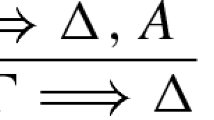Abstract
Motivated by constraint satisfaction problems, Feder and Vardi (SIAM Journal of Computing, 28, 57–104, 1998) set out to search for fragments \({\mathcal{L}}\) of \(\Sigma_1^1\) satisfying the dichotomy property: every problem definable in \({\mathcal{L}}\) is either in P or else NP-complete. Feder and Vardi considered in this connection two logics, strict NP (or SNP) and monadic, monotone, strict NP without inequalities (or MMSNP). The former consists of formulas of the form \(\exists \vec{X}\forall \vec{x} \phi\), where \(\phi\) is a quantifier-free formula in a relational vocabulary; and the latter is the fragment of SNP whose formulas involve only negative occurrences of relation symbols, only monadic second-order quantifiers, and no occurrences of the equality symbol. It remains an open problem whether MMSNP enjoys the dichotomy property. In the present paper, SNP and MMSNP are characterized in terms of partially ordered connectives. More specifically, SNP is characterized using the logic D of partially ordered connectives introduced in Blass and Gurevich (Annals of Pure and Applied Logic, 32, 1–16, 1986), Sandu and Väänänen (Zeitschrift für Mathematische Logik und Grundlagen der Mathematik, 38, 361–372 1992), and MMSNP employing a generalization C of D introduced in the present paper.
Similar content being viewed by others
References
Atserias, A. (2005). On digraph coloring problems and treewidth duality. In Proceedings of the 20th Annual Symposium on Logic in Computer Science (LICS 2005), pp. 106–115.
Atserias, A. (2006). On digraph coloring problems and treewidth duality. Retrieved April 1, 2007, from Albert Atserias’ homepage, Universitat Politècnica de Catalunya: http://www.lsi.upc.es/~atserias/research.html.
Barwise J. (1969). Applications of strict \(\Pi^1_1\) predicates to infinitary logic. Journal of Symbolic Logic 34: 409–423
Barwise J. (1979). On branching quantifiers in English. Journal of Philosophical Logic 8: 47–80
Blass A., Gurevich Y. (1986). Henkin quantifiers and complete problems. Annals of Pure and Applied Logic 32: 1–16
Bulatov, A. (2002). A dichotomy theorem for constraints on a three-element set. In Proceedings of the 43rd Symposium on Foundations of Computer Science (FOCS 2002), pp. 649–658.
Dawar, A., & Grädel, E. (1995). Generalized quantifiers and 0–1 laws. In Proceedings of the 10th Annual Symposium on Logic in Computer Science (LICS 1995), pp. 54–64.
Ebbinghaus H.-D., Flum J. (1999). Finite model theory. Springer, Berlin
Enderton H.B. (1970). Finite partially-ordered quantifiers. Zeitschrift für Mathematische Logik und Grundlagen der Mathematik 16: 393–397
Fagin, R. (1974). Generalized first-order spectra and polynomial-time recognizable sets. In R. Karp (Ed.), Complexity of Computation, SIAM-AMS Proceedings (Vol. 7, pp. 43–73).
Fagin R. (1975). Monadic generalized spectra. Zeitschrift für Mathematische Logik und Grundlagen der Mathematik 21: 89–96
Feder T., Vardi M. (1998). The computational structure of monotone monadic SNP and constraint satisfaction: A study through datalog and group theory. SIAM Journal on Computing 28: 57–104
Gottlob G. (1997). Relativized logspace and generalized quantifiers over finite ordered structures. Journal of Symbolic Logic 62: 545–574
Gottlob, G., Leone, N., & Veith, H. (1995). Second order logic and the weak exponential hierarchies. In J. Wiedermann & P. Hájek (Eds.), Proceedings of the 20th International Symposium on Mathematical Foundations of Computer Science (MFCS 1995), Lecture Notes In Computer Science, (Vol. 969, pp. 66–81). London: Springer.
Hell P., Nešetřil J. (1990). On the complexity of H-coloring. Journal of Combinatorial Theory, Series B 48: 92–110
Hella, L., & Sandu, G. (1995). Partially ordered connectives and finite graphs. In M. Krynicki, M. Mostowski, & L. Szczerba (Eds.), Quantifiers: Logics, models and computation, (Vol. 2, pp. 79–88). Dordrecht: Kluwer.
Hintikka, J. (1973). Quantifiers vs. quantification theory. Dialectica, 27, 329–358. Reprinted in Linguistic Inquiry, 5, 153–77, 1974.
Immerman N. (1999). Descriptive complexity. Springer, New York
Kolaitis, P., & Vardi, M. (1987). The decision problem for the probabilities of higher-order properties. In Proceedings of the nineteenth annual ACM conference on Theory of computing (STOC 1987), pp. 425–435.
Krynicki M. (1993). Hierarchies of finite partially ordered connectives and quantifiers. Mathematical Logic Quarterly 39: 287–294
Krynicki, M., & Mostowski, M. (1995). Henkin quantifiers. In M. Krynicki, M. Mostowski, & L. Szczerba (Eds.), Quantifiers: Logics, models and computation, (Vol. 1, pp. 193–262). Dordrecht: Kluwer.
Krynicki M. (1993). Hierarchies of finite partially ordered connectives and quantifiers. Mathematical Logic Quarterly 39: 287–294
Krynicki, M., & Mostowski, M. (1995). Henkin quantifiers. In M. Krynicki, M. Mostowski, & L. Szczerba (Eds.), Quantifiers: Logics, models and computation, (Vol. 1, pp. 193–262). Dordrecht: Kluwer.
Krynicki M., Väänänen J. (1989). Henkin and function quantifiers. Annals of Pure and Applied Logic 43: 273–292
Ladner R.E. (1975). On the structure of polynomial time reducibility. Journal of the Association for Computing Machinery 22: 155–171
Mostowski, M. (1991). Arithmetic with the Henkin quantifier and its generalizations. In F. Gaillard & D. Richard (Eds.), Séminaire du Laboratoire Logique, Algorithmique et Informatique Clermontois, (Vol. II, pp. 1–25).
Papadimitriou C. (1994). Computational complexity. Addison-Wesley, Reading, MA
Sandu G., Väänänen J. (1992). Partially ordered connectives. Zeitschrift für Mathematische Logik und Grundlagen der Mathematik 38: 361–372
Schaefer, T. (1978). The complexity of satisfiability problems. In Proceedings of the 10th annual ACM symposium on Theory of computing (STOC 1978), pp. 216–226.
Sevenster, M. (2006). Branches of imperfect information: Games, logic, and computation. Dissertation, ILLC, Universiteit van Amsterdam.
Sevenster, M., & Tulenheimo, T. (2006). Partially ordered connectives and \({\Sigma}_1^1\) on finite models. In A. Beckmann, U. Berger, B. Löwe, & J. V. Tucker (Eds.), Logical Approaches to Computational Barriers. 2nd Conference on Computability in Europe (CiE 2006), Lecture Notes in Computer Science, (Vol. 3988, pp. 516–525). Berlin: Springer.
Walkoe W. J. Jr., (1970). Finite partially-ordered quantification. Journal of Symbolic Logic 35: 535–555
Author information
Authors and Affiliations
Corresponding author
Additional information
Research for the present paper was initiated while the first author participated in the program Logic and Algorithms at the Isaac Newton Institute for Mathematical Sciences (University of Cambridge), and the other two authors visited him in June 2006.
Rights and permissions
About this article
Cite this article
Hella, L., Sevenster, M. & Tulenheimo, T. Partially Ordered Connectives and Monadic Monotone Strict NP. J of Log Lang and Inf 17, 323–344 (2008). https://doi.org/10.1007/s10849-008-9058-5
Received:
Accepted:
Published:
Issue Date:
DOI: https://doi.org/10.1007/s10849-008-9058-5




